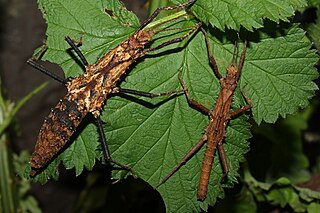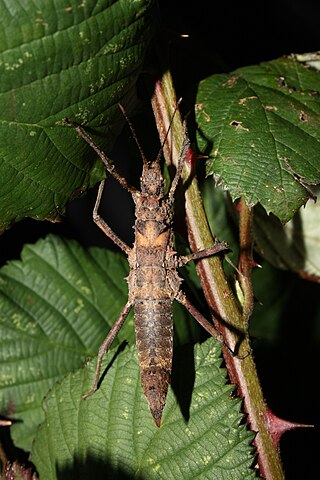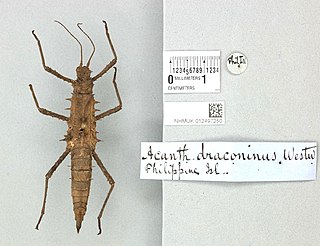
The Heteropterygidae is a family of stick insects belonging to the suborder Euphasmatodea. Species can be found in Australasia, East and Southeast Asia. More than 130 valid species have been described.

The Obriminae are the most species-rich subfamily of the Phasmatodea family Heteropterygidae native to Southeast Asia. It is divided into two tribe.

Hoploclonia is the only genus of the tribe Hoplocloniini and brings together relatively small and darkly coloured Phasmatodea species.

The genus Tisamenus native to the Philippines combines small to medium-sized species of stick insects.

Aretaon is a genus of stick insects native to Borneo and the Philippine island Palawan.

Eubulides is a stick insect genus native to the Philippines.
Trachyaretaon gatla is a species of Phasmatodea native to the Philippine island Palawan.

Tisamenus serratorius is a stick insect species that occurs on the Philippine island Luzon.

Tisamenus deplanatus is a stick insect species native to the Philippine islands Luzon and Mindanao occurs.

Tisamenus fratercula is a stick insect species native to the Philippine island Luzon.

Hoploclonia cuspidata is a stick insect species native to the north of Borneo and is also called Brunei Hoploclonia stick insect.

Tisamenus clotho is a stick insect species native to the Philippines.

Heterocopus is a monotypic stick insect genus, containing Heterocopus leprosus as the only valid species.

Haaniella saussurei is a species of stick insect native to Borneo and a typical representative of the subfamily Heteropteryginae. The occasionally used common name Saussure's Haaniella refers to the species name.
Pterobrimus is a monotypic genus of stick insects (Phasmatodea), containing the species Pterobrimus depressus, wich is native to Fiji.

Tisamenus draconina is a species of stick insect in the family Heteropterygidae native to the Philippines.

Tisamenus ranarius is a stick insect species (Phasmatodea), in the family of the Heteropterygidae native to the Philippines.

Tisamenus hebardi is a stick insect species (Phasmatodea), in the family of the Heteropterygidae endemic to the north of the Philippine island of Luzon.

Tisamenus hystrix is a stick insect species (Phasmatodea), in the family of the Heteropterygidae endemic to the Philippines.

Tisamenus lachesis is a stick insect species (Phasmatodea), in the family of the Heteropterygidae endemic to the Philippine Polillo Island.

















